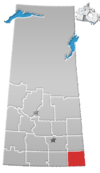Arcola, Saskatchewan
Arcola | |
|---|---|
Town | |
| Nickname: City of Angels | |
Location of Arcola in Saskatchewan | |
| Coordinates: 49°38′13″N 102°29′24″W / 49.637°N 102.490°W | |
| Country | Canada |
| Province | Saskatchewan |
| Region | Saskatchewan |
| Census division | 1 |
| Rural Municipality | Brock |
| Post office Founded | 1889 |
| Incorporated (Village) | N/A |
| Incorporated (Town) | N/A |
| Government | |
| • Mayor | Jimmy Workman |
| • Town Manager | Christie Hislop |
| • Governing body | Arcola Town Council |
| Area | |
| • Total | 3.39 km2 (1.31 sq mi) |
| Population (2011)[1] | |
| • Total | 649 |
| • Density | 191.5/km2 (496/sq mi) |
| • National Population Rank (Out of 5,008) | 3,006th |
| Time zone | CST |
| Postal code | S0C 0G0 |
| Area code | 306 |
| Highways | Highway 13 Highway 604 |
| Climate | Dfb |
| [2][3] | |
Arcola is a town in southeast Saskatchewan, Canada, approximately 60 kilometres (37 mi) north and 40 kilometres (25 mi) east of Estevan. Highway 13, Highway 604 and Arcola Airport provide access to the community.
Arcola served as the location for the Allan King film feature of W.O. Mitchell's Who Has Seen the Wind.[4]
History

In 2003, Arcola celebrated its 100th anniversary, marking the fact that it predates the province by two years. Arcola is known as Saskatchewan's "Heritage Town" due to its many historical brick and wood frame structures.[4] Settlers in the area originally built a community known as Clare, located two miles northeast of where Arcola exists today, but almost all the buildings of Clare were moved when the CPR announced in the early part of 1900 that the railroad would run south of town. Arcola was the "end point" of the southern branch line running west from Souris, Manitoba for four years, during which time it became an important hub for westward migration. At one point it was the 11th largest town in what is now the province of Saskatchewan, but was then known as Assiniboia. With flourishing settlement and economic growth, many thought Arcola would achieve city status. It was during this heyday and using bricks made in the town's own brick plant that many of today's heritage homes and buildings were erected.[4]
Heritage buildings
Arcola has several heritage properties registered on the Canadian Register of historic places.[5]
- Arcola Town Hall (Arcola Opera House) (1905) at 21 Main Street
- Arcola Court House (1908 to 1909) at 619 Souris Avenue
- Law Office Building (1916) at 114 Main Street
- Arcola Land Titles Building (1911 to 1912) at 301 Main Street
- Pharmacy Building (1903) at 107 Main Street
Demographics
| 2011 | |
|---|---|
| Population | 649 (27.5% from 2006) |
| Land area | 3.39 km2 (1.31 sq mi) |
| Population density | 191.5/km2 (496/sq mi) |
| Median age | 36.3 (M: 36.0, F: 36.4) |
| Private dwellings | 303 (total) |
| Median household income |
Education
Arcola School offers Kindergarten through grade 12 and is in the South East Cornerstone School Division #209. This public school has an enrollment of 215. The Panthers are the school team.[9]
Attractions
A fair and rodeo, town wide garage sale day, Robbie Burns' Night, Co-Op Equity Days, a snowmobile rally, fall supper, and Canada Day Celebrations are among the town's annual events.
The town is home to an art gallery and the Southeast Saskatchewan Photo Museum. A full range of stores and services are available including three antique shops, a hospital and medical clinic, a K-12 school and pottery studio, as well as full service restaurants, a laundromat and a motel.
Following the destruction by fire of the skating and curling rinks in 2001, the area residents banded together to rebuild the rinks next to the Prairie Place Hall, to create a multi-use community facility comparable to that in most cities.
Notable people
- Gerald McLellan (1932-2009), lawyer and Ombudsman for Saskatchewan, 1987-1993; also a bencher of the Law Society of Saskatchewan, 1976-1982. Born and educated in Arcola.[10]
- Canadian author James Sinclair Ross wrote his seminal 1941 novel As for Me and My House in Arcola.[4]
- Arcola is the hometown of former Vancouver Canucks, and NCAA All American ice hockey defenceman, Prestin Ryan.[11]
Transport links
Arcola Airport is nearby.
See also
References
- ^ "2011 Community Profiles". Statistics Canada. Government of Canada. Retrieved 4 Sep 2013.
- ^ National Archives, Archivia Net. "Post Offices and Postmasters". Archived from the original on 6 October 2006. Retrieved 4 September 2013.
{{cite web}}: Unknown parameter|deadurl=ignored (|url-status=suggested) (help) - ^ Government of Saskatchewan, MRD Home. "Municipal Directory System". Archived from the original on 15 January 2016. Retrieved 4 September 2013.
{{cite web}}: Unknown parameter|deadurl=ignored (|url-status=suggested) (help) - ^ a b c d Canada's Digital Collection. "Pioneering Photography". Retrieved 4 September 2013.
- ^ Arcola, Saskatchewan. "Canada's Historic Places". Retrieved 4 September 2013.
- ^ "2011 Community Profiles". 2011 Canadian census. Statistics Canada. March 21, 2019. Retrieved 2012-05-29.
- ^ "2006 Community Profiles". 2006 Canadian census. Statistics Canada. August 20, 2019.
- ^ "2001 Community Profiles". 2001 Canadian census. Statistics Canada. July 18, 2021.
- ^ Arcola School. "South East Cornerstone School Division # 209". Retrieved 4 September 2013.
- ^ Speers Funeral Chapel, Memorial Notice - Gerald Peter McLellan. Retrieved 2016-10-15.
- ^ "Prestin Ryan". Retrieved 4 September 2013.



